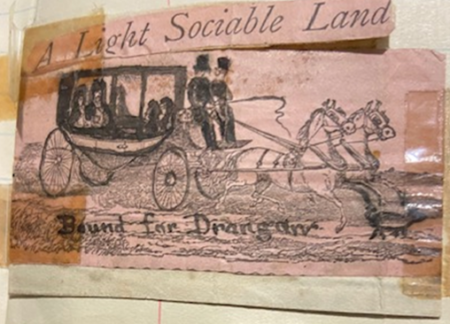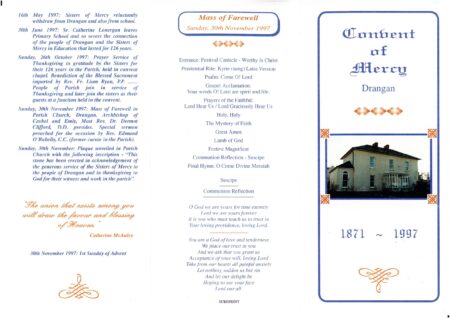Convent of Mercy, Drangan, Co Tipperary 1871 – 1997
The foundation of Drangan Convent of Mercy arose from a bequest by the parish priest of Drangan, who left his house and assets to the Sisters of Mercy in Tipperary for the foundation of a convent in the parish.
 Sketch of 1871 journey to Drangan from Annals of Tipperary Convent
Sketch of 1871 journey to Drangan from Annals of Tipperary Convent
Sisters of Mercy ministered in Drangan for 126 years, initially as a branch house of Tipperary Convent 1871 – 1920, and then of New Inn Convent to 1973 when the Union of the Sisters of Mercy of the diocese of Cashel & Emly was established,
The transfer of governance from Tipperary to New Inn was noted in the annals of both communities.
7th February, 1920 – Two mothers from New Inn Convent came to negotiate about taking over charge of our branch convent in Drangan. Their work in New Inn had been gradually growing less and future prospects of work there for a community of nuns seemed very uncertain, while we had our hands took full and with difficulty could carry on all. The monitresses were no longer available in the schools. The young Sisters had to study for certificates in order to be allowed to teach under Board and Sisters were also required to train as nurses before being acknowledged in hospitals. All this drew on the help of the Sisters and it became almost impossible to staff Drangan school as well as meet all the calls here.
20th July, 1920 – a gift of £155 subscribed by the people of Drangan and Cloneen was presented to the Sisters….in gratitude to the Sisters who had labored among them for fifty years (Annals, Tipperary Convent of Mercy)
On 12th March, 1920 the convent in Drangan was taken over by this community. Rev Mother Francis Cantwell, representing the Tipperary community, left Drangan that day. Sr. M. Catherine and Sr. M.
 Act of Chapter 1920 from Annals of New Inn, Covent of Mercy
Act of Chapter 1920 from Annals of New Inn, Covent of Mercy
Brigid took up duty in Drangan. Some of the Tipperary Sisters remained to initiate them. On Easter Saturday, 4th April, 1920, they left, and Mother Aloysius, Sr. M. Agatha and Sr. Agnes came from New Inn. The Tipperary community acted in a very noble and generous manner in relinquishing Drangan. They left every department in convent and school fully equipped, and left a £20 note in the cash box (Annals, New Inn Convent of Mercy)
In a 1997 homily at a Mass of thanksgiving for the Drangan Sisters of Mercy, Rev. Ted O’Rahelly, former curate of Drangan, acknowledged the Sisters of Mercy, who in the spirit of Catherine McAuley, give witness to their faith by serving their community.
166 years ago, nearly to the day, a young girl, Catherine McAuley, was moved with compassion and by the Spirit of God, to offer her energy and life, to relieve in some small way, the misfortune of some of the citizens of Dublin. What started in 1831 as small as a mustard seed, grew beyond all expectation. Within 10 years, her number of helpers had grown from 2 to 140 and were known as The Sisters of Mercy. Catherine McAuley saw the need for the education and nursing of the poor; she saw the need for visitation of the sick; for child care and for shelter and training for unemployed girls and with God’s grace her mission was founded.
40 Years later, in 1871, four Sisters of Mercy, came from Tipperary Town by pony and trap, and took up residence in a house donated by the late P.P. of Drangan, Fr. Edmond O’Shaughnessy. Shortly after arriving, the Sisters, in the spirit of Catherine McAuley, started extensive visitation of the parish, paying special attention to the poor and the sick and they converted a stable at the back of the convent so as to start a school.
The Sisters also inherited Fr. O’Shaughnessy’s cow, and the existing P.P., Fr. James Ryan, gave them permission to graze their cow in his field. The cow must have been eating too much grass because, a few years later, his successor ordered the Sister’s cow and calf to be put out of his field and on to the road. Only history will tell us is the present P.P., Fr. Liam Ryan addressed this injustice and, once again, allowed the Sisters to pasture their cow and calf in his field.
Catherine McAuley drew her inspiration from the person of Jesus. She read in St. John’s Gospel that Jesus desired that people ‘would have life and have it to the full’. She saw that Jesus was interested in offering people a better quality of life here and now. He stood for and worked towards bringing about, a situation in which people can achieve this true wholeness. He stood for a deep conversion – a change of heart in people from selfishness to love. The life of Jesus, what He said and what He did was the blueprint for Catherine McAuley and her followers, the Sisters of Mercy.
During His life, Jesus was present to His people through His physical body – it was that which drew people’s attention to His presence, just as it is our bodies that draw people to our presence. It was by seeing what he did and hearing what He said that people came to know and understand Him in the first instance.
Today, Jesus is no longer present in the world in that way – today, nobody knows what His voice sounded like. But if He is to have any effect in today’s world, He has to be present in some bodily way – otherwise His presence would pass altogether unnoticed and would be ineffective. The visible way in which He is present today to the world is through the community of His followers, us, the Church. It is this which draws attention to His presence today, which speaks His words today and does His work today. One of the functions of the local Church is to be His bodily presence in the area in which it exists.
In the Gospels, Jesus is presented, not at all as a self seeking person, but as one who served. St. Luke’s Gospel says that He stood among the people of His time ‘as one who serves’. In St. Mark’s Gospel, He says of Himself, ‘For the Son of Man did not come to be served, but to serve’.
Since Jesus stood in the world as ‘one who serves’, it follows that the Church, the community which center’s around Him and is meant to embody Him, is, or ought to be – and ought to be seen to be – a serving community, one committed to performing a service Furthermore – and his sometimes comes as a surprise to people – all who are members of this community are themselves called to be involved in performing this service. One cannot be said to be a serious member of a body whose function it is to serve unless one regards oneself as being jointly responsible for this service.
So the Church is not a ‘spiritual supermarket’ in which each one does his or her own spiritual shopping, regardless of other people around. In belonging to the Church, we are part of a service orientated community and a community of people who are themselves committed to service. Church membership means service and so we can see that ‘it is in giving that we receive’.
 Mass of Farewell, 1997
Mass of Farewell, 1997
To find out about the service to which we are all called, we must go to the Gospels and find out what Jesus stood for and who He served in His day. Each of the four Gospels emphasizes different aspects of Jesus and His mission. All the Gospels set His ministry against a background of wounded people, those excluded from society – the sick, the poor, those who were deaf and dumb, the lame, te lepers, the blind, the possessed, the tax collectors and the sinners. Jesus was very sensitive to, and deeply involved with human hurt. He had a terrific capacity for compassion. His compassion led Him to be critical, harshly critical of anyone or any system, even a religious one, which caused people to be wounded or which prolonged their hurt.
Jesus has shown us the way that we should live. The many Sisters of Mercy who worked in this parish have shown us. We must learn from their example and continue to build God’s Kingdom here in this little corner of Christendom.
Today, we salute the Sisters of Mercy for their commitment; their dedication. Today, we thank them for their sterling service over 126 years in this parish. Today, we wish them God’s blessing for what they have given and for what they may do in the future.
No doubt, their leaving will leave a huge void in the area around Drangan. Just like in a relay race, they are now handing on the baton to all the good Christian people of Drangan to give witness to the faith they profess with their lips by being of service to all in the community. Just as the life of a Mercy Sister is a life of service – the life of every committed Christian is a life of service.
Sisters;
You have come from a great tradition
You are part of a great tradition
You have left us a great tradition
We thank you
(Homily, Rev. Ted O’Rahelly)
Marianne Cosgrove
Congregational Archivist


